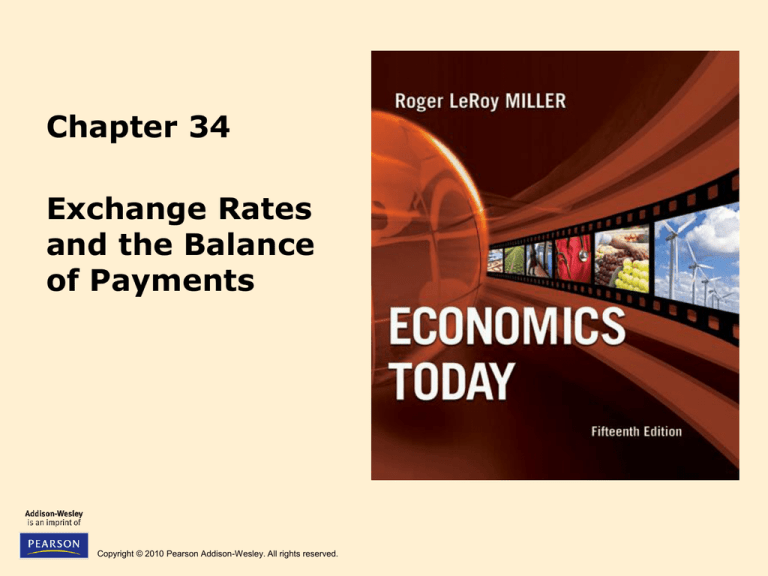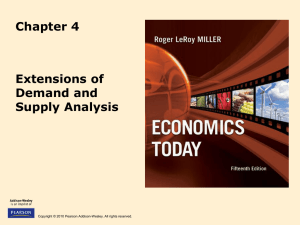
Chapter 34
Exchange Rates
and the Balance
of Payments
Copyright © 2010 Pearson Addison-Wesley. All rights reserved.
Chapter Outline
• The Balance of Payments and International
Capital Movements
• Determining Foreign Exchange Rates
34-2
Copyright © 2010 Pearson Addison-Wesley. All rights reserved.
The Balance of Payments and International
Capital Movements (cont'd)
• Balance of Payments
– A system of accounts that measures transactions
of goods, services, income and financial assets
between domestic households, businesses, and
governments and residents of the rest of the
world during a specific time period
• Balance of Trade (merchandise)
– The difference between exports and imports of
goods
34-3
Copyright © 2010 Pearson Addison-Wesley. All rights reserved.
The Balance of Payments and International
Capital Movements (cont'd)
• Three categories of balance of payments
transactions
1. Current account transactions (goods & services)
2. Capital account transactions (foreign
investment)
3. Official reserve account transactions (difference
of the above two)
34-4
Copyright © 2010 Pearson Addison-Wesley. All rights reserved.
Table 34-2 U.S. Balance of Payments Account,
2009 (in billions of dollars)
34-5
Copyright © 2010 Pearson Addison-Wesley. All rights reserved.
The Balance of Payments and International
Capital Movements (cont'd)
• Balancing the current account
– Net exports plus unilateral transfers plus net
investment income exceeds zero
• Current account surplus
– Net exports plus unilateral transfers plus net
investment income is negative
• Current account deficit
34-6
Copyright © 2010 Pearson Addison-Wesley. All rights reserved.
The Balance of Payments and International
Capital Movements (cont'd)
• A current account deficit means that we are
importing more goods and services than we
are exporting.
• A current account deficit must be paid by
the export of money or money equivalent.
• What happens to the foreigners who have
more of your money?
34-7
Copyright © 2010 Pearson Addison-Wesley. All rights reserved.
The Balance of Payments and International
Capital Movements (cont'd)
• The current account and capital account
must sum to zero
– In the absence of interventions by finance
ministries or central banks
Capital account Current account 0 or
Capital account = - Current account
34-8
Copyright © 2010 Pearson Addison-Wesley. All rights reserved.
Figure 34-1 The Relationship Between the
Current Account and the Capital Account
Sources: International Monetary Fund; Economic Indicators.
Copyright © 2010 Pearson Addison-Wesley. All rights reserved.
34-9
Determining Foreign Exchange Rates
• When you buy foreign
products, you have
dollars.
• But the foreign
country can’t pay
workers in dollars.
• So there must be a
way of exchanging
these dollars.
34-10
Copyright © 2010 Pearson Addison-Wesley. All rights reserved.
Determining Foreign Exchange
Rates (cont’d)
• Foreign Exchange Market
– A market in which households, firms and
governments buy and sell national currencies
• Exchange Rates
– The price of one nation’s currency in terms of
another
34-11
Copyright © 2010 Pearson Addison-Wesley. All rights reserved.
Determining Foreign Exchange
Rates (cont'd)
• The equilibrium foreign exchange rate
– Appreciation
• An increase in the exchange value of one nation’s
currency in terms of the currency of another nation
– Depreciation
• An decrease in the exchange value of one nation’s
currency in terms of the currency of another nation
34-12
Copyright © 2010 Pearson Addison-Wesley. All rights reserved.
International Example: Going Loony
over an Appreciating Loonie
• One face of a Canadian dollar coin
displays an image of a bird called the
loon, so the Canadian dollar is
informally known as the “loonie.”
• In the mid-2000s, the loonie was
worth only about 75 U.S. cents.
• In the late 2000s, however, its value
had soared to over 1 U.S. dollar.
• Hence, U.S. residents cut back on visits to Canada, because
prices of touring Canada and its goods and services
increased.
• Which groups in the United States gained and which lost
when the loonie appreciated?
34-13
Copyright © 2010 Pearson Addison-Wesley. All rights reserved.
Determining Foreign Exchange
Rates (cont'd)
• Appreciation and depreciation of Euros
– We say your demand for euros is derived from
your demand for European drugs.
• Example
– Assume the pharmaceuticals
cost 100 euros per package.
– If 1 euro costs $1.45, then a
package of pharmaceuticals
would cost $145 (100 euros).
34-14
Copyright © 2010 Pearson Addison-Wesley. All rights reserved.
Figure 34-4 Total Demand for and
Supply of Euros
34-15
Copyright © 2010 Pearson Addison-Wesley. All rights reserved.
Figure 34-5 A Shift in the Demand
Schedule
More imports
from Europe
(by Americans)
raise the
demand for the
euro
34-16
Copyright © 2010 Pearson Addison-Wesley. All rights reserved.
Figure 34-6 A Shift in the Supply
of Euros
More imports
of US goods
(by Europeans)
raise the supply
for the euro
(and raise the
demand for the
US dollar)
34-17
Copyright © 2010 Pearson Addison-Wesley. All rights reserved.
Myth #34: Because of trade deficits,
we are in trouble
• Not yet. It’s just toys for tots.
• Give me toys and I’ll give you buildings.
34-18
Copyright © 2010 Pearson Addison-Wesley. All rights reserved.








